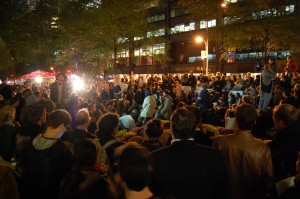proteseters
As Injured Vets Return Home, Churches Reach Out. Occupy Wall Street Gears Up For The Big Day. Faith Overtones In Occupy Protests But Leaders Wary. OpEd: How The First Amendment Got Hijacked. Religious Groups Offer Help To Evicted Protesters. OpEd: What Happens When A Seminary Is Occupied? Religious Voices Loud And Clear At Keystone XL Protests. Iowa Scientists Ask Candidates To Acknowledge Climate Change. And Below The Line: Portraits Of American Poverty.
 Throughout the day here at the #OccupyWallStreet mass demonstrations in New York's financial district, you can find small and often somber groups meeting.
Throughout the day here at the #OccupyWallStreet mass demonstrations in New York's financial district, you can find small and often somber groups meeting.
They have agendas, a facilitator, a time keeper, and someone to keep track of the "stack" -- the list of people waiting to make a point or ask a question.
And they also have a system of hand gestures -- a sort of gonzo sign-language adaptation of Roberts Rules of Order -- designed to keep the discussion and decision-making process both democratic and efficient.
When someone agrees with a point the speaker is making, the crowd raises two hands in agreement. When the crowd disagrees, hands quickly go up, making a downward pointing motion. To call a "point of process" crowd members shape their hands into a triangle to stop discussion. Speakers who wander off topic are quickly redirected and reminded of the point being discussed in the agenda.
These working groups bring their recommendations to the #OccupyWallStreet General Assembly, which takes place once a day. A vote is taken to determine consensus before a recommendation is passed along to the G.A.
Anyone participating in the General Assembly can block a proposal by forming an X with their arms. Participants make their case and then a revised proposal is put forth. The revised proposal can then be passed with a 90/10 consensus.